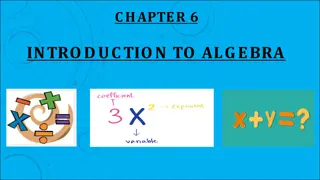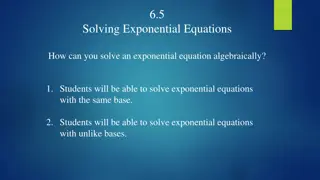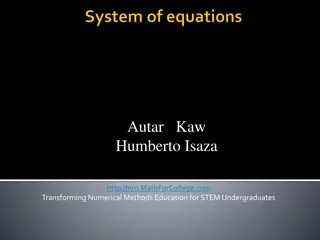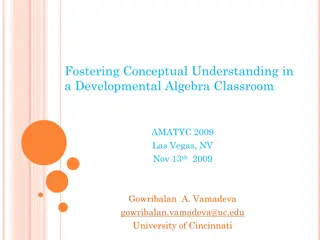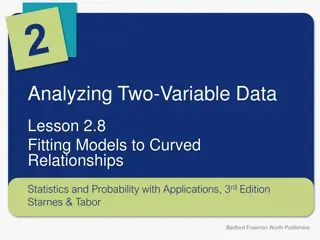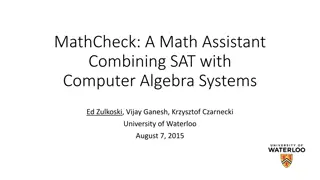Understanding Exponential Variable Solving in Financial Algebra
Explore examples of solving for exponential variables in financial algebra, focusing on the concept of how long funds should remain in a single deposit account to reach a specific savings goal. Learn about compound interest calculations and logarithmic methods to determine the time needed to achieve desired account balances.
Download Presentation

Please find below an Image/Link to download the presentation.
The content on the website is provided AS IS for your information and personal use only. It may not be sold, licensed, or shared on other websites without obtaining consent from the author. Download presentation by click this link. If you encounter any issues during the download, it is possible that the publisher has removed the file from their server.
E N D
Presentation Transcript
2-9 The Term of a Single Deposit Account Advanced Financial Algebra
How long should funds ($) remain in a single deposit savings account? You need to start now to plan for large expenses in the future. When trying to figure out how long money should stay in an account to have saved a certain amount, we must solve for an exponential variable using a logarithm (log).
Example 2 Solving for an exponential variable Anna deposited $1,000 into an account paying 2% annual interest compounded semi- annually. How long will it take for her to have $1,061.52? SOLUTION: P = $1,000 r = 2% = .02 t = ?? A = $1,061.52n = 2 compounded semi-annually ? ?)(??) .02 2)(2 ?) A = P(1 + 1061.52 = 1000(1 + 1061.52 = 1000 * 1.01 2t 1.06152 = 1.01 2t Log 1.01 1.06152 = 2t divide both sides of equation by 1000 change to logarithm form change of base formula log 1.06152 log 1.01 divide both sides of equation by 2 = 5.999985742 = 2? It will take about 3 years to have $1,061.52 in the account. ? 3
Example 4 Nancy and Bob are renovating their kitchen. They deposited $16,000 in an account at 2.4% annual interest compounded monthly. When will they have $20,00 for their kitchen project? SOLUTION: P = $16,000 r = 2.4% = .024 t = ?? A = $20,000 n = 12 compounded monthly ? ?)(??) .024 12)(12 ?) A = P(1 + 20000 = 16000 * 1.002 12t 1.25= 1.002 12t Log 1.002 1.25 = 12t log 1025 log 1.002= 111.68 = 12? ? 9.3 20000 = 16000(1 + divide both sides of equation by 16000 change to logarithm form change of base formula divide both sides of equation by 12 It will take about 9.3 years to save up for the kitchen.
Example 5 continuous compounding Pete deposits $8,000 into an account paying 3.7% annual interest compounded continuously. How long will it take for him to have $10,000? SOLUTION: P = $8,000 Use A = P(?)(??) 10000 = 8000(?)(.037?) 1.25 = e .037t Log e 1.25 =.037t Ln 1.25 = .037t r = 3.7% = .037 for continuous compounding divide both sides of equation by 8000 change to logarithm form Log e is the natural logarithm ln divide both sides of equation by .037 It will take about 6 years to have $10,000 in the account. t = ?? A = $10,000 ? 6
Assignment: FIN. ALG. GREY BOOK PG 127 #2, 7, 10 and BLUE ALG. II BOOK pg 489 #64, 67, 71 #2
Assignment: FIN. ALG. GREY BOOK PG 127 #2, 7, 10 and BLUE ALG. II BOOK pg 489 #64, 67, 71 con t #7 #10




